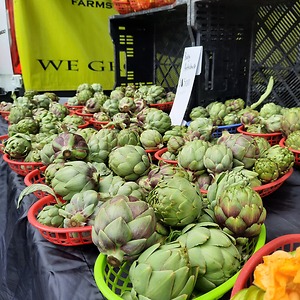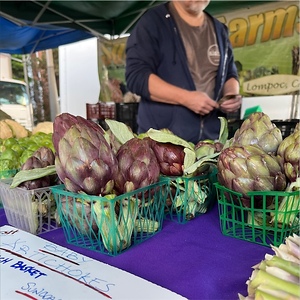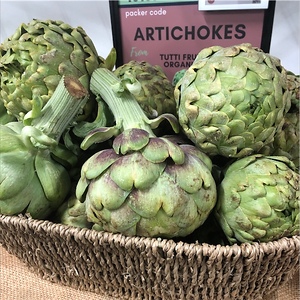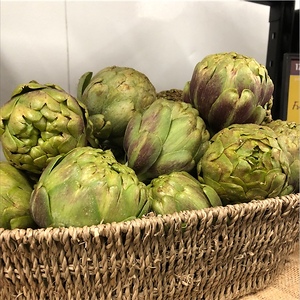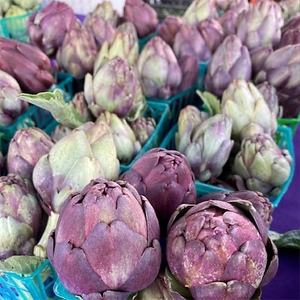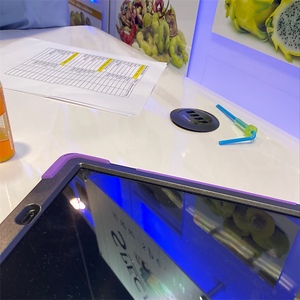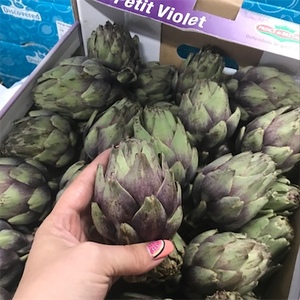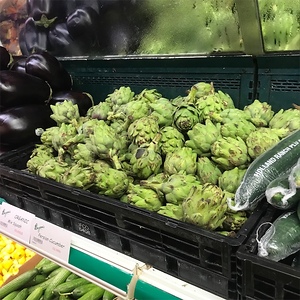


Baby Anzio Artichokes
Estimated Inventory, lb : 0
Description/Taste
Baby Anzio artichokes are a small variety, averaging 2 to 5 centimeters in diameter, and have a round to oval shape. The compact floret is comprised of many tightly layered, edible fleshy bracts, which are protective layers that encase a developing flower bud. Each bract is smooth, semi-thick, and succulent, bearing variegated purple, brown, and green hues. Some of the bracts may also contain a few needle-like thorns on the outer leaves, and these thorns should be removed before consumption. As the bracts are peeled away, they reveal a core that is nearly chokeless, meaning the center of the bud only contains a few hair-like fibers, and the center flesh has a tender, soft consistency. When cooked, Baby Anzio artichokes develop a sweet, nutty, and grassy flavor with subtle caramel notes.
Seasons/Availability
Baby Anzio artichokes are available year-round, with peak seasons in the spring and fall.
Current Facts
Baby Anzio artichokes, botanically classified as Cynara scolymus, are the unopened flower heads of an herbaceous perennial belonging to the Asteraceae family. The green and purple buds are a variety of globe artichoke, and despite the “baby” descriptor, Baby Anzio artichokes are fully mature, grown on the lower portions of the plant and shaded from the sun, preventing the buds from increasing in size. Baby Anzio artichokes are favored for their sweet, nutty flavor, tender texture, and small size, and are utilized by chefs for their fast-cooking nature and easy preparation. The cultivar is traditionally grown throughout Italy, France, and Spain, but in the late 20th century, Central California growers also began cultivating the variety.
Nutritional Value
Baby Anzio artichokes are a good source of folate, a B vitamin that helps the body create genetic material, vitamin K to assist in faster wound healing, and vitamin C to strengthen the immune system. The artichokes also contain fiber to regulate the digestive tract and lower amounts of magnesium, potassium, phosphorus, and iron.
Applications
Baby Anzio artichokes require minimal preparation and are fast-cooking, best suited for heated applications such as roasting, steaming, boiling, frying, and grilling. When slow-cooked, the artichokes develop a tender consistency and absorb accompanying flavors, creating a flavorful side or main dish ingredient. Baby Anzio artichokes can be braised in garlic and thyme butter, coated in olive oil and lemon and grilled, or steamed and topped over pasta, pizza, and sandwiches. The artichokes can also be roasted and served as an appetizer with homemade dips such as aioli, baked with herbs, or sauteed with spring vegetables. Baby Anzio artichokes pair well with herbs such as parsley, mint, and dill, cheeses such as parmesan, feta, goat, and chevre, lemon, aromatics such as shallots, onion, and garlic, poultry, fish, other seafood, potatoes, spinach, and tomatoes. The artichokes will keep for 1 to 2 weeks when stored in a plastic bag in the refrigerator.
Ethnic/Cultural Info
In the town of Ladispoli, Italy, an annual festival dedicated to the artichoke occurs each spring to honor the local culinary ingredient. The festival has been held for over 70 years and is known as the Romanesco Artichoke Festival, a name used to describe the primary variety of artichoke grown within the region, the roman or romanesco artichoke. The festival also features many other artichoke varieties, including Baby Anzio artichokes, and there are over 100 food vendors that sell fresh, cooked, and preserved artichokes throughout the three-day event. One of the most popular Italian artichoke dishes at the festival is carcofi alla giudia, which are deep-fried artichokes in olive oil. In addition to food, the artichoke festival hosts cooking contests, educational talks about artichokes, and features artists who use the globe-like buds to create art installations and sculptures.
Geography/History
Artichokes are native to the Mediterranean and have been cultivated for thousands of years. The plants were known during Ancient Greece and went through many centuries of falling in and out of popularity as a culinary ingredient. In the 16th century, artichokes were introduced into England, and in the 19th century, they were brought to the New World with settling European immigrants. Baby Anzio artichokes are believed to be a relative of the romanesco artichoke of the Lazio region of Italy, but the exact history of the variety’s origins is unknown. Today Baby Anzio artichokes are primarily cultivated in Italy, France, Spain, and Central California. They are also sometimes grown in Australia and Egypt. When in season, the artichokes are found on a limited basis through farmer's markets and specialty grocers.
Recipe Ideas
Recipes that include Baby Anzio Artichokes. One







